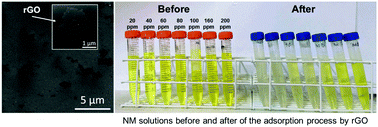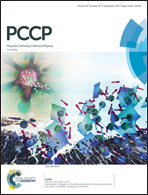Adsorption of anti-inflammatory nimesulide by graphene materials: a combined theoretical and experimental study†
Abstract
Interactions of anti-inflammatory nimesulide (NM) with different graphene material species were explored employing both ab initio calculations, based on Density Functional Theory (DFT), and a batch adsorption process. The adsorption of NM onto graphene, with and without a vacancy, reduced graphene oxide (rGO) and functionalized graphene nanoribbons was simulated, providing a good understanding of the adsorption process of the NM molecule onto graphene material surfaces. The theoretical results indicate a physisorption interaction between NM and all of the evaluated adsorbents. Based on batch adsorption experiments, it was found that rGO, obtained via a modified Hummers method, is a good nanoadsorbent for the removal of the anti-inflammatory NM from aqueous solutions. The general-order kinetic equation displays the best fit to the experimental data compared with pseudo-first order and pseudo-second order kinetics. The equilibrium data fitted well into the Liu isotherm equation, and the maximum sorption capacity for the adsorption of NM by rGO was 82.4 mg g−1 at 25 °C. Our results of the first principle calculations and the batch adsorption experiments point out that graphene materials are promising nanomaterials for extracting NM from aqueous solutions.



 Please wait while we load your content...
Please wait while we load your content...